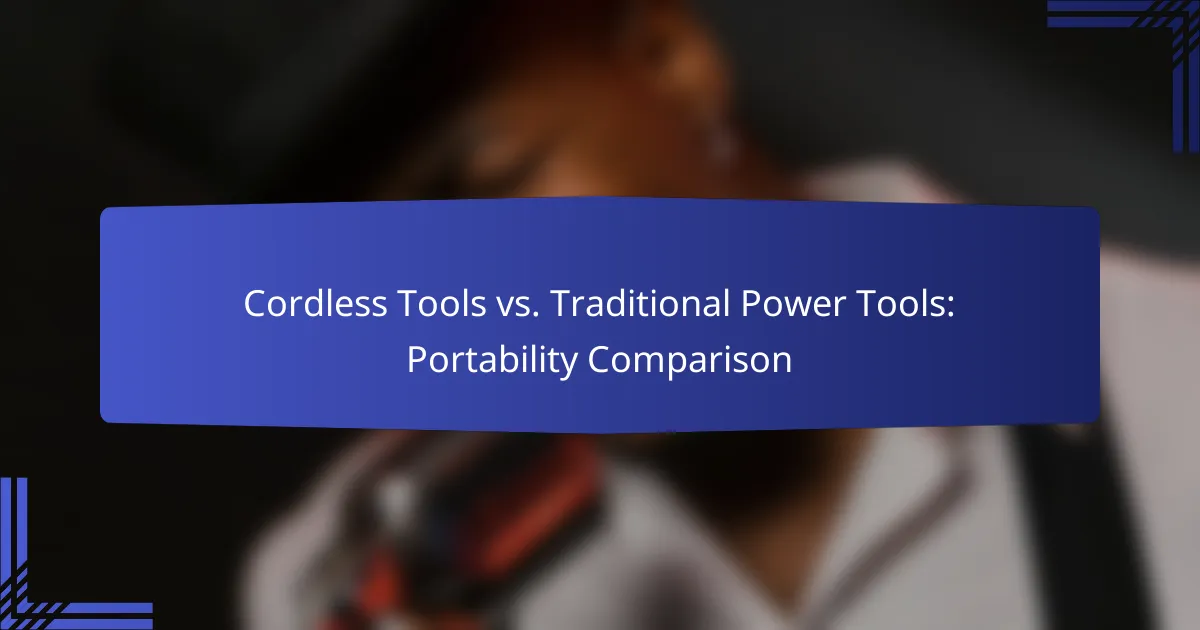Cordless tools have revolutionized the way we approach various projects by providing unmatched portability and convenience. Unlike traditional power tools, which require a constant power source, cordless options allow users to work freely in diverse environments, making them a popular choice for both professionals and DIY enthusiasts. However, it’s essential to consider the trade-offs, such as limited runtime and potential higher costs, when choosing between these two types of tools.

What are the advantages of cordless tools over traditional power tools?
Cordless tools offer significant advantages over traditional power tools, primarily in terms of mobility and convenience. Their portability allows users to work in various locations without being tethered to a power source, making them ideal for both professional and DIY projects.
Enhanced portability
The most notable benefit of cordless tools is their enhanced portability. Without the need for a power cord, users can easily transport these tools to different job sites or move around freely within a workspace. This flexibility is particularly useful for outdoor projects or in areas where power outlets are scarce.
Many cordless tools are lightweight and compact, which further contributes to their ease of handling. For instance, a cordless drill typically weighs less than its corded counterpart, making it easier to maneuver in tight spaces.
Ease of use
Cordless tools are designed for user-friendly operation, often featuring simple controls and quick setup. Users can start working immediately without the hassle of finding an outlet or managing cords. This convenience is especially beneficial for tasks that require frequent movement, such as landscaping or home repairs.
Additionally, many cordless tools come with ergonomic designs that enhance comfort during prolonged use. Features like rubber grips and balanced weight distribution help reduce fatigue, allowing for more efficient work sessions.
Reduced clutter
Using cordless tools significantly reduces clutter in the workspace. Without cords to manage, users can maintain a cleaner and safer environment, minimizing tripping hazards. This is particularly advantageous in small or crowded areas where space is limited.
Furthermore, fewer cords mean less time spent setting up and packing away tools. This efficiency allows users to focus more on their projects rather than on organizing their equipment.
Battery technology improvements
Recent advancements in battery technology have greatly enhanced the performance of cordless tools. Modern lithium-ion batteries offer longer run times, faster charging, and improved durability compared to older battery types. Users can now expect several hours of continuous use on a single charge, depending on the tool and application.
Additionally, many cordless tools now feature smart battery management systems that optimize power usage and extend battery life. This means users can work longer without interruptions, making cordless tools even more reliable for demanding tasks.
Versatile applications
Cordless tools are suitable for a wide range of applications, from light household tasks to heavy-duty construction work. Their versatility allows users to tackle various projects with a single tool type, such as drills, saws, and impact wrenches.
For example, a cordless impact driver can be used for assembling furniture, installing fixtures, or even automotive repairs. This adaptability makes cordless tools a valuable addition to any toolkit, catering to both casual users and professionals alike.

What are the disadvantages of cordless tools compared to traditional power tools?
Cordless tools offer convenience but come with notable disadvantages compared to traditional power tools. Key drawbacks include limited runtime, higher initial costs, and the need for battery replacements, which can affect overall efficiency and long-term expenses.
Limited runtime
One of the main disadvantages of cordless tools is their limited runtime due to battery life. Most cordless tools can operate for a few hours before needing a recharge, which may not be sufficient for larger projects. Users should consider the specific tasks they plan to undertake and whether they can manage with the available battery duration.
To mitigate this issue, it’s advisable to have multiple batteries on hand. This allows for quick swaps during work, minimizing downtime and maintaining productivity.
Higher initial cost
Cordless tools typically have a higher initial purchase price compared to their traditional counterparts. The cost of advanced battery technology and the convenience of portability contribute to this premium. Depending on the brand and features, the price difference can range from 20% to 50% more for cordless options.
When budgeting for tools, consider not just the upfront cost but also the long-term value. Investing in a quality cordless tool can pay off if it meets your needs effectively and lasts longer than cheaper alternatives.
Battery replacement needs
Another significant drawback of cordless tools is the need for battery replacements over time. Batteries can degrade after a few hundred charge cycles, leading to diminished performance and the eventual need for a new battery. This can add to the overall cost of ownership.
It’s wise to check the warranty and expected lifespan of the batteries before purchasing. Some manufacturers offer extended warranties or battery recycling programs, which can help manage replacement costs and environmental impact.

How do cordless tools perform in various tasks?
Cordless tools offer convenience and flexibility, making them suitable for a wide range of tasks. Their performance can vary based on the specific application, battery capacity, and tool design.
Drilling performance
Cordless drills are generally effective for light to medium-duty drilling tasks, especially in wood and drywall. For tougher materials like metal or masonry, consider models with higher torque and battery power.
When selecting a cordless drill, look for features such as adjustable speed settings and clutch settings to enhance control. Battery life can significantly impact performance, so opt for tools with lithium-ion batteries for longer usage times.
Sawing capabilities
Cordless saws, including reciprocating and circular saws, excel in portability, making them ideal for on-site projects. However, their cutting power may not match that of traditional corded saws, especially for heavy-duty applications.
For optimal sawing performance, choose a model with a robust battery and consider the blade type suited for your material. Regularly check battery levels to avoid interruptions during cutting tasks.
Impact driving efficiency
Cordless impact drivers are highly efficient for driving screws and fasteners, often outperforming standard drills in speed and torque. They are particularly useful in construction and assembly tasks where speed is essential.
To maximize efficiency, use impact-rated bits and ensure the battery is fully charged before starting. Be cautious with softer materials, as excessive torque can strip screws or damage surfaces.

What factors should you consider when choosing between cordless and traditional power tools?
When choosing between cordless and traditional power tools, consider factors such as the type of projects you’ll undertake, how often you’ll use the tools, and your budget. Each option has unique advantages and disadvantages that can significantly impact your work efficiency and overall satisfaction.
Project type
The type of projects you plan to tackle plays a crucial role in your tool selection. Cordless tools are ideal for tasks requiring mobility, such as outdoor work or projects in tight spaces where outlets are unavailable. Traditional power tools, on the other hand, may be better suited for heavy-duty tasks that demand consistent power and performance.
For instance, if you’re working on a large construction site, traditional tools might provide the reliability needed for extensive use. Conversely, if you’re a DIY enthusiast handling small home repairs, cordless options may offer the flexibility you need.
Frequency of use
Your frequency of use will influence whether you should invest in cordless or traditional power tools. If you plan to use the tools regularly, traditional power tools may be more cost-effective in the long run due to their durability and performance. However, if your usage is infrequent, cordless tools can provide convenience without the hassle of cords.
For example, a contractor who uses tools daily might prioritize traditional options for their robustness, while a homeowner who only needs tools for occasional projects may find cordless tools sufficient for their needs.
Budget considerations
Budget is a significant factor when choosing between cordless and traditional power tools. Generally, cordless tools can be more expensive upfront due to battery technology, but they may save you money on extension cords and power consumption over time. Traditional tools typically have a lower initial cost but may require additional expenses for cords and maintenance.
Consider setting a budget range for your tool purchase. For instance, if you’re looking to spend between $100 and $300, you might find a good selection of quality cordless tools that fit your needs, while traditional tools in the same range may offer more power but less portability.

How do leading brands compare in cordless tool offerings?
Leading brands like DeWalt, Makita, and Milwaukee each offer unique advantages in their cordless tool lines, focusing on battery life, power, and versatility. Understanding these differences can help you choose the right tools for your needs, whether for professional or DIY projects.
DeWalt cordless tools
DeWalt is known for its robust range of cordless tools that emphasize durability and performance. Their 20V MAX system provides a wide selection of tools that share batteries, making it convenient for users to switch between devices without downtime.
When considering DeWalt, look for features like brushless motors, which enhance efficiency and runtime. Their tools are often favored in construction settings due to their reliability and power, making them suitable for heavy-duty tasks.
Makita cordless tools
Makita offers a diverse lineup of cordless tools, particularly noted for their lightweight designs and advanced battery technology. The 18V LXT platform allows for compatibility across a broad range of tools, ensuring flexibility for users.
One key aspect of Makita tools is their fast charging capabilities, which can recharge batteries in under an hour. This feature is particularly beneficial for professionals who need to minimize downtime during projects.
Milwaukee cordless tools
Milwaukee is recognized for its innovative approach to cordless tools, focusing on high-performance options that cater to demanding applications. Their M18 and M12 systems provide extensive choices for both heavy-duty and compact tools.
Milwaukee tools often incorporate advanced technology, such as REDLINK intelligence, which optimizes performance and prevents overload. Users appreciate the long battery life and the ability to handle tough jobs, making Milwaukee a popular choice among tradespeople.

What are the best practices for maintaining cordless tools?
To maintain cordless tools effectively, regularly check and care for the battery, clean the tool after use, and store it properly. These practices can extend the lifespan of your tools and ensure optimal performance.
Battery Care
Proper battery care is crucial for the longevity of cordless tools. Always charge the battery according to the manufacturer’s guidelines, avoiding overcharging or letting it drain completely. Ideally, store batteries in a cool, dry place and charge them periodically if not in use for extended periods.
For lithium-ion batteries, aim to keep the charge between 20% and 80% to maximize lifespan. Regularly inspect the battery for any signs of damage or swelling, and replace it if necessary to maintain tool efficiency.
Cleaning and Maintenance
Cleaning your cordless tools after each use helps prevent dust and debris buildup, which can affect performance. Use a soft brush or cloth to remove dirt from the tool’s exterior and check for any blockages in vents or moving parts.
Additionally, lubricate moving parts as recommended by the manufacturer to ensure smooth operation. Regular maintenance checks can help identify potential issues before they become serious problems.
Storage Practices
Storing cordless tools properly is essential for their longevity. Keep them in a dry, temperature-controlled environment to prevent moisture damage and corrosion. Use a dedicated toolbox or storage case to avoid physical damage and keep tools organized.
When storing tools for long periods, consider removing the battery and storing it separately. This practice can help maintain battery health and ensure that your tools are ready to use when needed.
